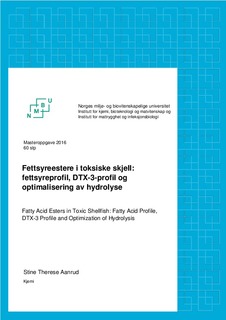| dc.contributor.advisor | Ekeberg, Dag | |
| dc.contributor.author | Aanrud, Stine Therese | |
| dc.coverage.spatial | Norge | nb_NO |
| dc.date.accessioned | 2016-08-10T11:28:10Z | |
| dc.date.available | 2016-08-10T11:28:10Z | |
| dc.date.issued | 2016-08-10 | |
| dc.identifier.uri | http://hdl.handle.net/11250/2398646 | |
| dc.description.abstract | Denne oppgaven studerte hvordan skjell kan danne fettsyreestere fra toksiner som forsvarsmekanisme. Likheter og forskjeller i fire arter ble vurdert ved å sammenligne dannelse av dinophysistoksin-3 (DTX-3) fra fettsyrer (FA), FA-profilen og konsentrasjon av okadasyre (OA-) gruppetoksiner. Kunnskap om toksiner i skalldyr langs den norske kysten er viktig for å forhindre potensielt skadelig inntak av giftige skalldyr.
For å få informasjon om dannelsen av DTX-3 ble analyser utført for å optimalisere hydrolysen og bestemme konsentrasjon av OA-gruppetoksiner ved bruk av LC-MS/MS. En metode for bestemmelse av ulike DTX-3-toksiner ble utviklet for LC-MS/MS og FA-profilen i skjellene ble funnet ved bruk av GC-MS. Analysene ble utført på 33 prøver av toksiske og ikke-toksiske blåskjell (Mytilus edulis), kamskjell (Pecten maximus), O-skjell (Modiolus modiolus) og stillehavsøsters (Crassostrea gigas).
En forbedret metode for hydrolyse ble utarbeidet, og består i å ha 150 µL 4,0 M NaOH i H2O i et polypropylen (PP-) rør med 1,2 mL skjellekstrakt. Prøvene settes i et 37 °C vannbad i 45 minutter og avkjøles i 20-30 minutter før hydrolysen avsluttes ved tilsetting av 150 µL 4,25 M HCl i metanol. Selv om metoden er forbedret bør videre undersøkelser av temperatur og tid for hydrolyse utføres for å oppnå størst mulig grad av hydrolyse for OA-gruppetoksinene.
Metoden for bestemmelse av ulike DTX-3-toksiner detekterte DTX-3-profil for ti prøver blåskjell. I tillegg ble ett DTX-3-toksin bestemt i 13 skjellprøver. Toksiner med fettsyreesterne C16:0, C16:1 og C18:1 var dominerende i alle DTX-3-profilene.
En fettsyreprofil for alle prøvene ble rapportert. De dominerende fettsyrene i alle artene var C16:0 (20 – 25%), C16:1 cis 9 (10 – 15%), C20:5 cis 5,8,11,14,17 (10 – 20%) og C22:6 cis 4,7,10,13,16,19 (15 – 20%), med unntak av østers som inneholdt mindre enn 5% C16:1 cis 9 og O-skjell som inneholdt mindre enn 10% C22:6 cis 4,7,10,13,16,19.
Alle prøver har en større andel C16:0, C16:1 og C18:0 i DTX-3-profilen enn i FA-profilen. Det motsatte er tilfellet for C20:5 og C22:6. Dette indikerer at når DTX-3 dannes, skjer prosessen sannsynligvis ved forestring av medium korte, mettede FAr. Det er en høy andel lengre, umettede FAr skjellene, men disse blir i mindre grad benyttet til dannelse av DTX-3, noe som kan skyldes at DTX-3 med umettede FAr er mer giftig for skjellene (Yanagi et al., 1989). | nb_NO |
| dc.description.abstract | The aim of this thesis was to consider how shellfish produce fatty acid (FA) esters from toxins as a defense mechanism. Similarities and differences of four species of shellfish was considered by comparing the making of dinophysistoxin-3 (DTX-3) from FA, the FA profile and the concentration of ocadaic acid (OA) group toxins. Knowledge of toxins in shellfish found along the Norwegian shore is crucial in order to circumvent potential harmful intake of toxic shellfish.
To discover information on the production of DTX-3, an optimization of the hydrolysis was done and the concentration of OA group toxins was determined by LC-MS/MS. An analytical method to examine the share of different DTX-3 toxins was developed for LC-MS/MS, and the profile of FA in shellfish was found using GC-MS. All analyses were performed on 33 samples of toxic and non-toxic blue mussels (Mytilus edulis), scallops (Pecten maximus), northern horsemussles (Modiolus modiolus) and pacific oysters (Crassostrea gigas).
An improved method for hydrolysis was developed, which consists of adding 150 µL 4.0 M NaOH in H2O to a polypropylene (PP-) plastic tube with 1,2 mL of shellfish extract. The sample was placed in a 37 °C water bath for 45 minutes, cooled for 20-30 minutes and then hydrolysis was stopped by adding 150 µL 4.25 M HCl in methanol. Even though the method is improved, more testing of the optimal temperature and time for the hydrolysis is necessary to accomplish the highest degree of hydrolysis for the OA group toxins.
The method to determine different DTX-3 toxins resulted in a DTX-3 profile in ten samples of toxic blue mussels. In addition, one DTX-3 toxin was detected in 13 samples of shellfish. Toxins containing the FAs C16:0, C16:1 and C18:0 are most abundant in the DTX-3 profiles.
An FA profile of all samples was reported. The most abundant FAs in all species was C16:0 (20 – 25%), C16:1 cis 9 (10 – 15%), C20:5 cis 5,8,11,14,17 (10 – 20%) and C22:6 cis 4,7,10,13,16,19 (15 – 20%), except oysters which contained less than 5% C16:1 cis 9 and northern horsemussels which contained less than 10% C22:6 cis 4,7,10,13,16,19.
All samples show a higher share of C16:0, C16:1 and C18:0 in the DTX-3 profile than the FA profile. It is the other way around for C20:5 and C22:6. This indicates that when DTX-3 is created, the process often occurs by esterification with medium short, saturated FAs. Longer, more unsaturated FAs represent a high share of the FAs in shellfish, but they have a lower chance of being used for DTX-3 toxins, which may be because toxins containing unsaturated FA-esters are more toxic to the shellfish (Yanagi et al., 1989). | nb_NO |
| dc.language.iso | nob | nb_NO |
| dc.publisher | Norwegian University of Life Sciences, Ås | |
| dc.subject | Algetoksiner | nb_NO |
| dc.subject | Dinophysistoksin-3 | nb_NO |
| dc.subject | Fettsyreprofil | nb_NO |
| dc.subject | Blåskjell | nb_NO |
| dc.title | Fettsyreestere i toksiske skjell : fettsyreprofil, DTX-3-profil og optimalisering av hydrolyse | nb_NO |
| dc.title.alternative | Fatty Acid Esters in Toxic Shellfish: Fatty Acid Profile, DTX-3 Profile and Optimization of Hydrolysis | nb_NO |
| dc.type | Master thesis | nb_NO |
| dc.subject.nsi | VDP::Mathematics and natural science: 400::Chemistry: 440::Analytical chemistry: 445 | nb_NO |
| dc.source.pagenumber | 130 | nb_NO |
| dc.description.localcode | M-KJEMI | nb_NO |
